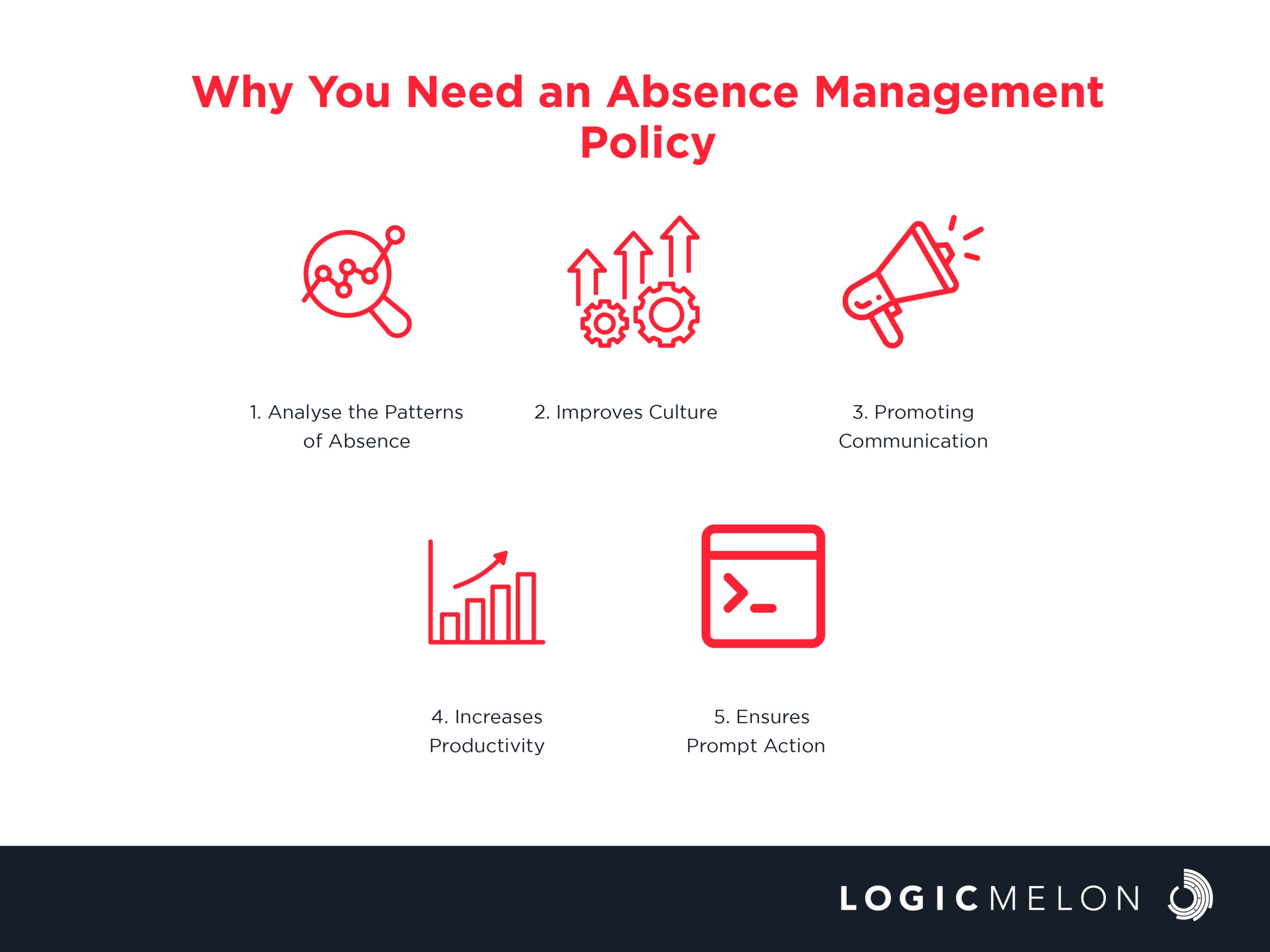What Is Absence Management, and Why Do You Need It?
Absence management is identifying the root cause of the employee’s absence and takes the necessary actions to reduce it. As a result, the productivity and morale of employees are raised. To achieve this, you need effective time-off rules, frequent one-on-one meetings, a supportive work environment, and several other measures. Since absence has a bad connotation, it is also known as “attendance management” in some workplaces.
Absence Management Policy
When an employee is absent from work as a result of illness, your company should have a clear policy in place that outlines their responsibilities and rights. According to the law, you must advise your staff of the conditions of sickness or injury, including provisions for sick pay and any other benefits. The policy should include the following:
- Provide information about contractual sick pay, its rules, and how it relates to statutory sick pay.
- Explain the procedures for notifying the workplace of an illness, including when it started, how the employee is resolving it, and who should be notified if the employee is unable to report to work.
- Specify the timeframe (number of days) by which you anticipate the worker to complete the self-certification form.
- If your company has a review or trigger point system, explain how it works and when it is used.
- Explain that any changes that must be made after the employee returns to work are to be implemented as soon as it is practical to do so. Provide advice on how to handle absences during unfavorable situations, like the recent COVID-19 pandemic and severe weather.
- Any disciplinary measures for excessive or unjustified absences should be made known, indicating that the absence policies will be upheld and those unauthorised absences will not bepermitted.
- Also, keep in mind that any absence management strategy should not be enforced in a way that violates anti-discrimination laws. An employer must support any employees who have disabilities or health conditions to avoid breaking disability discrimination laws.
- It is essential to keep in mind that the law may also include disorders related to physical and mental health.
Why You Need an Absence Management Policy

1. Analyse the Patterns of Absence
Companies can recognise their organisation’s absence trend and take proactive steps to prevent or correct it if they have an effective employee absence management system in place. If there is a sickness pattern, a lack of motivation, or an issue with the team manager, it should be detected early and fixed.
2. Improves Culture
A transparent absence management system may clear up any misunderstandings and eliminate any misconceptions about absenteeism, which can enhance the culture of the company as a whole. Workers would be more willing to take sick days and arrange vacations with their colleagues, strengthening team unity and cooperation.
3. Promoting Communication
Employers and employees must speak with one another about the employees’ jobs and personal lives as a condition of absence management. It enhances dialogue between managers and staff. Falsehoods are eliminated via open communication, which lowers employee stress levels.
4. Increases Productivity
Employee productivity increases in direct proportion to employee absences. Having an absence management policy has long-standing advantages, one of which is that it can boost productivity within your company.
5. Ensures Prompt Action
By making it simpler to see an employee who is taking too many absences, absence management enables prompt action. Decide whether to have a “getting back to work” interview, impose discipline, or lower the employee’s pay. All of these actions can take place automatically and without any confusion.
Improve Your Absence Management
1. Concentrate on Employee Wellness
By promoting employee well-being inside your company, you may improve absence management. Employees who enjoy their jobs are more likely to show up for work. In-house counselors and weekly check-ins with managers to review performance can both contribute to employee well-being. They are better able to clarify their objectives and comprehend their contribution to the expansion of the business.
2. Make Workplace Lively
Making sure your employees love coming to work each day should be another key objective. Make the workplace lively by including creative furnishings, entertaining areas, dedicated spaces for focused work, and games. Reducing boredom in the workplace can lower absenteeism.
3. Provide Flexibility
Flexibility is by far the best strategy to enhance employee absence management. If an employee has the option to arrive to work a bit later or leave a little earlier to attend a doctor’s appointment or his child’s school play, they won’t miss work. Instead, they’ll step in when it’s convenient and get the job done. Being overly strict disrupts the personal lives of your employees, making them angry. Give them room to work and have faith in them to get the job done.
4. Good Absence Management Software
Workers may not be aware that they are taking excessive amounts of time off or using too many sick days. This occurs when your HR department records every detail about absences on separate sheets and keeps the data to themselves. Your employees can track their time off and absence patterns, and be aware of their absences with the use of appropriate absence management software, which can help you cut down on excessive absenteeism.
Frequently Asked Questions
1. What Are the Five Signs That You Should Develop an Absence Management Policy?
Here are the five signs that you should develop an absence management policy:
- Employee productivity drops
- Poor quality of the work
- Insufficient work-life balance
- Higher employee churn
- Patterns of Toxic Culture
2. What Are the Two Types of Absences?
Authorized and unauthorised absences are the two basic categories. Genuine sick leave is also counted as an authorised absence. But authorised absences typically involve planning, such as annual leave. False sick days and carelessness are examples of unauthorized absences.
3. What Is Absence Management in HRM?
Using rules and procedures, absence management in HRM aims to lower absenteeism. Such policies must be well explained to staff members and managers to be effective, and HR must be proactive in enforcing them.
Closing Thoughts
Employers lose money due to employee absences, both in terms of the hours not worked and the time required to manage the absence, get cover, and offer assistance as needed upon return to work. However, staff members may be absent from work for a variety of reasons, making absences from work an inevitable aspect of running an organisation. By putting in place an efficient absence management plan, you can accommodate employees’ requirements while keeping an eye on unauthorised absences or the abuse of sick leave benefits.
LogicMelon
Award-winning recruitment software that will find, attract, hire and analyse the way you want to work. At LogicMelon, we have experienced software recruitment marketing specialists to help you build effective recruitment solutions supported by the best customer service you’ll find anywhere!
Email: sales@logicmelon.com or call LogicMelon (UK) +44 (0) 203 553 3667 (USA) +1 860 269 3089
Recruitment Data Visualisation: Everything You Must Know
As a recruiter, you go through a lot of information daily. Recruitment data visualisation simplifies the complex data, making it easier to understand and act upon.
The Role of Soft Skills in Leadership Recruitment
In leadership development, soft skills are essential for identifying individuals who can not only manage but also inspire and guide teams to success.
ATS and CRM in Talent Acquisition
By utilising the strengths of ATS and CRM, organisations can create a comprehensive talent acquisition strategy that combines relationship building with an efficient hiring process.


